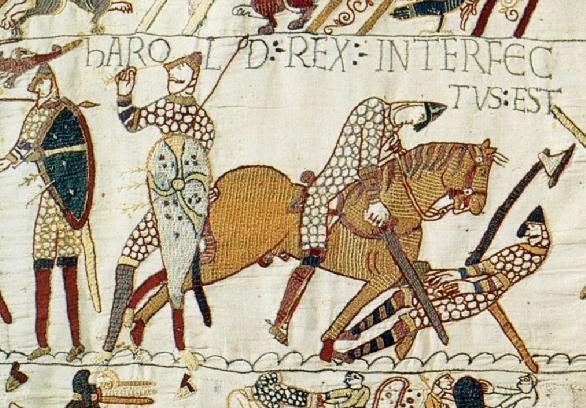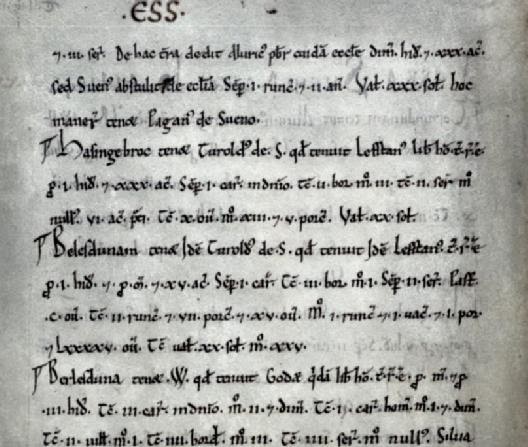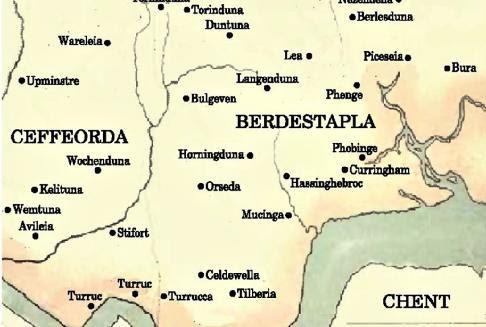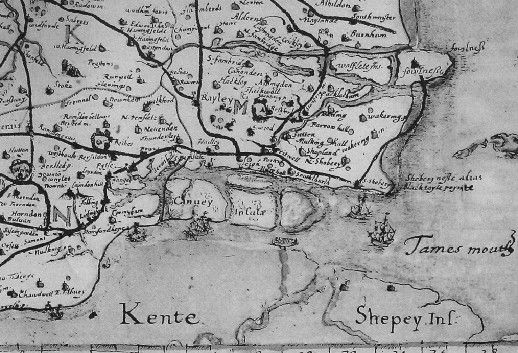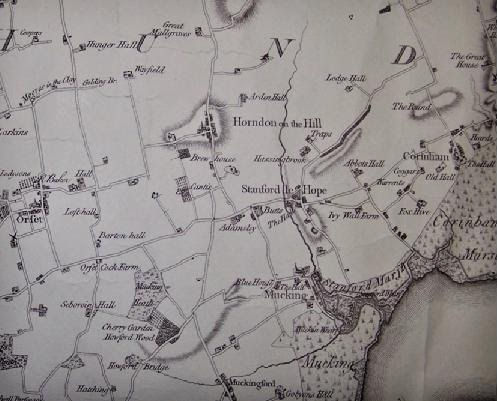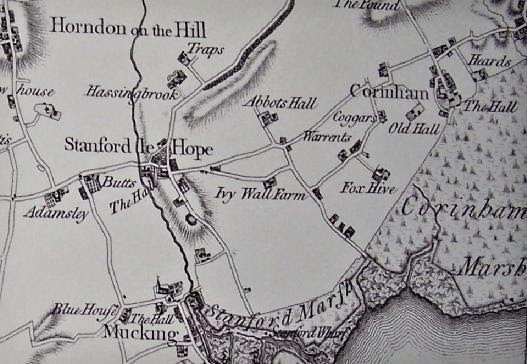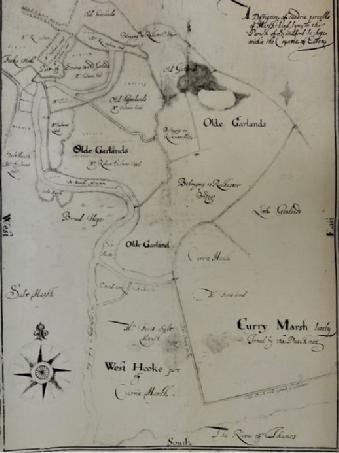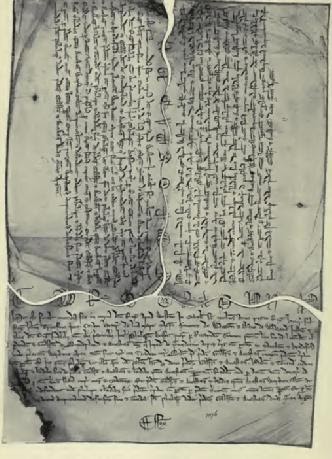The Norman Conquest
During the reign of Edward the Confessor from 1042 to 1066 the lands in the area were held in parts. The greater part consisting of 12 hides and 13½ acres was held by sixteen free men with 11 ploughs. There was woodland for 200 swine, 16 acres of meadow and pasture for 400 sheep. A lesser part was held by Leofstan, another freeman, comprising one hide and 30 acres with one plough. There were 2 bordars and 2 serfs with 6 acres of meadow and 10 sheep and a further part was held by Alric and Ulwin.
Edward, who had spent many years in exile in Normandy was a weak king who during his reign continued to rely on the support of the Normans appointing many of them to positions of authority particularly within the Church. Edward’s death in January 1066 sparked a dispute as to the succession to the English crown. Harold Godwinson, Edward’s brother-in-law, was the most powerful of the English nobility and his most obvious successor. He was elected by a Witenagemot, a council of Saxon Kings, and crowned by the archbishop of York. Guillaume (William) of Normandy laid claim to the crown on the basis that Edward had promised it to him and that Harold had agreed to this. King Harald Sigurdsson of Norway, known as Harald Hardrada ‘the stern ruler,’ also laid claim citing an earlier agreement between his predecessor Magnus I and an earlier English king Harthacnut. On learning of Harold’s accession William and Harald Hardrada immediately began assembling fleets to invade England.
Knowing that both William and Harald Hardrada were likely to invade, King Harold assembled a large force and spent most of the summer of 1066 on the south coast waiting for William to cross the channel with his army. By early September all was still quiet and as many of Harold’s army were farmers and landowners they needed to return home to gather their harvests, so on the 8th September he allowed them to leave. Within a few days of having done so word was received that Harald Hardrada had landed on the north east coast of England with force of some 15000 men and 300 ships. Included in this force was the army of Tostig Godwinson King Harold’s exiled brother who had thrown in his lot behind Harald Hardrada’s bid for the English crown. Harald Hardrada moved rapidly inland routing a northern English army and capturing York. King Harold rushed north with his army recruiting additional forces as he went taking some ten days to reach York. Once there he learnt that Harald Hardrada and his army had moved east to the small village of Stamford Bridge. Harold and his army swooped on the village taking the Norwegians by surprise. On September 26th a bloody battle took place with Harald Hardrada and Tostig Godwinson both being killed and virtually all of their armies wiped out. So complete was the rout that of the 300 ships that had originally set sail for England only 25 returned, nevertheless the victory for King Harold had been costly as his army had also suffered losses and was left in a weakened state.
The exact size and composition of William’s invasion forces has never been reliably established. He crossed the channel with his army on 28th September landing at Pevensey and establishing a temporary wooden castle at Hastings from where he mounted raids to gather supplies for his army. Harold in the meantime had begun marching south from York with his depleted army having had to leave a large number of wounded behind. Harold reached London during the first week of October where he rested for about a week before resuming the march south to face William’s forces.
Again, the records are not clear about the size of Harold’s army but it is likely that it was outnumbered by William’sThe battle of Hastings took place on 14th October 1066 near the site of the present day town of Battle in Sussex. William and his forces advanced from their wooden castle at Hastings to be met by Harold at Senlac Hill. The battle lasted all day but the death of Harold in the afternoon marked the beginning of the end for the English forces. The Bayeux Tapestry famously shows Harold’s death as the result of an arrow in his eye but it is not known what exactly happened as his troops and bodyguards did not see who had delivered the fatal blow.
Following the battle William had expected the English to surrender the crown to him but instead the Witenagemot proclaimed Edgar the Etheling the new English King. William was thus forced to move on London. He advanced around the Kent coast towards the capital and defeated an English army in a battle at Southwark. He was not able however to storm London itself and instead took a route to the south and west. After defeating forces sent from London in a series of engagements, the English finally surrendered to him at Berkhamstead. William was thus proclaimed King of England and crowned on 25th December in Westminster abbey.
William’s coronation did not mark the end of the English resistance however. He had left England for Normandy in March 1067 leaving his half brother Odo Bishop of Bayeux as his tenant in chief but rebellions in Kent and Mercia forced his return at the end of the same year. It was not until 1075 following further rebellions that William established complete control over the country.
In the aftermath the English landowners and aristocracy were dispossessed in their entirety and their lands given over to William’s followers. Another effect was the introduction of the northern dialect of old French which displaced the Old English language.
A more benign result was the rapid elimination of slavery mostly owing to the opposition of the church to the practice, such that by the 12th century it had vanished, however many of the former free men were reduced in status to that of serfs.
The free men who had held the lands of Hassinghebroc were likewise dispossessed and replaced by Normans. Odo remained William’s tenant in chief and his vast landholdings included the lands of the parish. The transition from the Saxon ownership as previously described to Norman ownership is recorded in the Domesday Great Survey of 1086.
The Domesday Book was written in Latin with numerous abbreviations to lessen the work of the scribes. The Survey was compiled for William’s Government all of whose documents were written in Latin. The scholars and scribes who wrote the actual Domesday document were of the Church, again whose language was Latin with services and Bibles all written in that language.
Turold, steward to Geoffrey de Mandeville, and his son Ralph became Odo’s under tenants. Ralph held the part belonging to the sixteen freemen with the number of ploughs then seven.
There were 20 sokemen and 14 Bordars and the holding was worth 10 pounds. Turold held the land that had belonged to Leofstan. There remained 1 plough with 3 bordars and no serfs and the holding was worth 20 shillings. Sasselin held the part that had belonged to Alric and Ulwin. The shilling was an accounting artifice, there being no actual coin the equivalent of twelve pennies. The silver penny was the only coin in existence at the time of the Survey.
A hide of land was not a measure of its area as such but rather a figure on which tax or geld was levied and was subdivided into four virgates. The actual area of a hide was thus variable although it has been taken as the equivalent of about 120 acres. In counties that had been subject to Danish invasion the term carucate was used as synonymous with hide. The Acre; Rood; and Perch were the standard measures of land area until the metric system was adopted. An acre is 4840 square yards, the area that could be ploughed in one day, there are 4 roods of 1210 square yards to an acre, and there are 40 perches or poles each of 30¼ square yards to a rood. Thus there are 160 perches to an acre. The perch is also a linear measure of 5½ yards thus making the square perch of 30¼ square yards.
A plough consisted of the implement itself with a team of eight oxen and a hide or carucate was deemed to be the area that such a team could work in one ploughing season, nominally 120 days.
Sokemen, or freemen, were landholders in their own right renting directly from the under tenant with a measure of rights and responsibilities. Bordars were peasants of middle rank who held small amounts of land for their own cultivation but worked mainly for the under tenant or lord, in these cases Ralph and Turold. Serfs were the lowest order of peasantry working solely for the under tenant or lord with little land of their own.
Village names ending in ing or ham were of Saxon origin. Ing at the end of a place name was shortened from ingas meaning ‘the people of’ but if it appeared in the middle of the name it was shortened from inga meaning ‘belonging to’. Ham meant a village or settlement, thus Corringham would be Curra Inga Ham, the village belonging to Curra. Likewise, Fobbing would mean The People of Fobba, and Mucking or Mucinga, as it appears on the Domesday Map, the People of Mucca. Duna denoted a hill hence our modern word dune meaning sand hill so Wochenduna was Wocca’s Hill now Ockendon. Bura is now known as Bowers Gifford.
There were 20 households in total at the time of the Survey which was a considerable number exceeded in the Hundred of Berdestapla (Barstable) only by Burghesteda (Great Burstead) with 22 and Orseda (Orsett) also with 22. A Hundred was a subdivision of a county usually an area of 100 Hides with its own assembly of village representatives and notable persons. The seat and meeting place of the Hundred of Berdestapla was in its approximate geographical centre Berlesduna now known as Basildon.
John Norden’s Map of Essex 1594
Ogilby and Morgan’s Map of Essex 1678
Chapman and Andre Map of the Area 1777
Chapman & Andre Detail. The name Fox Hive was an alternative name for Great Garlands and Trapps which was probably later known as Moore Place
17th Century map of Curry Marsh and Old Garlands
The note at bottom right of this map reads “Curry Marsh lately Inned by the Dutchmen” and the “the Dutch wall against the Thames” Note also at the top left of the map, although it is difficult to read, is the name Fakes Hith. A century later this had morphed into the name Fox Hive on the Chapman and Andre map.
Subsequent to the Conquest the lands were divided into three Manors, the Manor of Hassingbrook, the Manor of Cabourne or Canvers, and Abbots Manor. The ownership of these Manors spanning the centuries has in the main been well documented, notably by Morant up to the time of his work in 1768. Rich sources of information regarding the ownership of land are documents known as Feet of Fines.
From the late twelfth century and subsequently for over six centuries, land conveyances were made by ‘final concords’ or ‘fines’ between the ‘querent’ – the purchaser, and the ‘deforciant’ – the seller. In the early fines the querent was sometimes described as the plaintiff. These early fines were made at the Court of Common Pleas but by the 14th century fines were also made at the Court of Kings Bench or the ambulatory Assize Courts. The agreement was written three times on a piece of parchment with two copies at the top of the document and one at the foot. These copies were delineated by a wavy or indented line. The document itself would be separated into three parts through the lines. The two parts at the top called the “Indentures” would be kept by the querant and the deforciant and the ‘Chirograph’ or ‘foot’ of the fine was retained by the court. This prevented any claim to the property by a stranger as only the original parties had in their possession documents that could be reassembled correctly to make the whole. Although the lands in question are described, in the absence of contemporary maps it is not always now apparent just where they were actually located.
Very large numbers of such fines were made, and have been painstakingly transcribed by scholars. A fine dating from 1348 is one of many relevant to Stanford-le-Hope. It reads (in transcription) Robert Gerlaund of Stanford the elder and Joan his wife, plaintiffs Richard Stamer and John de Berdestapel, deforciants) 1 messuage, 38 acres of land, 5 acres of pasture, 60 acres of marsh and 18s rent in Coryngham and Stanford by Thames. Pl(aintiffs) to hold for their lives of the chief lords, with successive remainders to Robert their son and Cristiana his wife and the heirs of their bodies, William brother of Robert the son and the heirs of his body, and the right heirs of Robert Gerlaund.
The land in ‘Coryngham and Stanford by Thames’ is that upon which Great Garlands farm now stands, Robert’s name being associated with the farm to this day. Messuage is a term for a house or other building and its grounds within a manor on which rent was payable.
